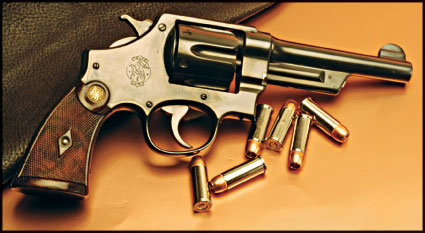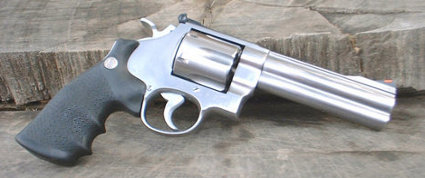
|
THE LIBERTARIAN ENTERPRISE Number 699, December 2, 2012 "Can America's slide into the totalitarian abyss be halted and reversed?"w3

First Model Hand Ejector 
Modern Hand Ejector—Model 629 "Classic" .44 Magnum Guntalk: S&W N-Frame Revolvers
Attribute to L. Neil Smith's The Libertarian Enterprise I've been exchanging messages over the past couple of weeks with a friend of mine who wants to buy a gun. It's slightly complicated since he's an antique enthusiast and wants to make a fashion statement, but at the same time, he wants something unquestionably adequate for self-defense. We'd been through quite a lot of stuff. It's surprising how much of yesterday's machinery still serves the purpose today. If I had to go into Harm's Way escorted by a Webley Mark VI in the original .455 caliber, I wouldn't feel a bit deprived or under-gunned. Unfortunately, many people seem to have caught on to that, and you can no longer get these oldies-but-goodies at scrap metal prices, as you could 30 years ago. Ordinary single action revolvers like the Ruger Blackhawk didn't suit my friend, nor any of the lesser brands, and Colts are way too expensive. He did briefly consider fitting a reproduction blackpowder sixgun (something like the 1858 Remington or a modern Ruger Old Army) with a third party cartridge cylinder. One of my fondest dreams (a modest one, but my own) is to outfit a pair of Rogers & Spencers this way. One day, out of the blue, he asked me about Smith & Wesson Hand Ejectors. The Hand Ejector is the direct ancestor to the whole family of S&W revolvers that are now familiar to gun enthusiasts, except, perhaps, for the tiny little Models 36/60, commonly called the Chief's Special. There are two original frame sizes, K (the size of the average police revolver 40 years ago before they took up Glocks) and N, the size of Dirty Harry's .44 Magnum Model 29. I happen to collect N-frames. If you're planning to defend yourself with one of these machines, I told my friend (and they are very good for that), you need to know that it's no good unless the cartridge it's made for starts with a "4". Smaller calibers than that have an unfortunate tendency to leave your assailant in a condition to sue you, or at least contradict your testimony. An exception is the .357 Magnum with a six-inch barrel. S&W made two N-frames in .357, both of them handsome, accurate, and powerful. But for weapons of the approximate vintage that my friend was most interested in, he was more or less restricted to something chambered in the older cartridges .38/40, .44/40, .44 Special, .45 Colt, or .45 ACP. .38/40 (the first number is the caliber, the latter number refers to its original black powder charge—my favorite rifle is a .45/70), also called .38 WCF for "Winchester Center Fire", is actually .40 caliber. Introduced in 1873, it has about the same power as today's .40 S&W. It was given the wrong initial number because of the way a gun's bore diameter was measured back then. Rifled barrels (spiral-cut inside so they put a spin on the bullet) have alternating "lands" and "grooves", the latter having been cut into the metal to provide the spin. The diameter of 19th century bores were measured land-to-land, instead of groove-to-groove. Which is why the .40 caliber cartridge we're discussing is called a .38. Likewise, in modern terms, all of those .44 caliber blackpowder "wheelguns" that "won the West" were .45s. .38/40 is a very good cartridge, flat-shooting (that is, with less trajectory than many another), accurate, and hard-hitting. It was quite popular in the late 19th century, then it fell out of style for a long time, and now it's back again thanks to cowboy competition shooting. Ruger has made some special custom single-action revolvers for .38/40, usually with a second cylinder chambered for .40 S&W or 10mm .44/40, also known as .44 WCF, was a sort of marketing companion to .38/40 in 1873. Like every American "44 caliber", its true bullet diameter is .429". That one, I can not explain. But this is the "44" you hear about in western songs and stories, quite splendidly powerful for the 19th century. Colt and nearly everybody else made revolvers for it and .38/40 both. Winchester made high-capacity lever action rifles of the kind you see John Wayne sling around (although I'm informed that the movie prop, the same gun Chuck Conners used as Lucas McCain in The Rifleman, is a .32/20—Wikipedia says .44/40, but movie production people have told me different). A cowboy could stuff both his sixgun and his saddle carbine with cartridges from the same box. Very handy. .44 Remington Special is not a member of the illustrious Class of '73, but came along in 1907, although it was based on 19th century items like .44 American and .44 Russian. The S&W Hand Ejector model made especially for this cartridge was known as the "44 New Century Triple Lock". The cartridge case shape and dimensions are different from those of .44/40. This is also an excellent—and remarkably accurate—cartridge, the direct predecessor to .44 Magnum. Marlin makes a 10-shot lever action Model 94 carbine chambered in .44 Magnum that will also shoot this cartridge. Factory-loaded ammunition is puny, but reloaders began changing that almost the minute it hit the market. Back to 1873, .45 Colt is the classic western handgun cartridge, but unlike .38/40 and .44/40, it didn't have to wait for cowboy shooting competition to come back into its own again after a long hiatus after World War II. In a S&W Hand Ejector, this is one of two cartridges I recommend most enthusiastically. In even its lightest loadings, at about 750 feet per second, its 255-grain bullet will "kill a man and make a horse sick", which was the Army criterion. In the right gun (not the Hand Ejector) it can be loaded to about 1200 feet per second, exceeding the effective power of .44 Magnum, but you won't need or want to do that. Spiffy Marlin lever-action rifles and carbines are available. The longer I live, the more I appreciate this cartridge. Finally, when the duplicitous Woodrow Wilson got America involved in World War I, the 1911 .45 caliber automatic Colt pistol couldn't be made in large enough numbers on existing machinery. As a consequence, the government contracted with Colt (on its New Service frame) and S&W (on its Hand Ejector frame) to build revolvers that would shoot the automatic pistol cartridge, employing special "half moon clips" to make up for its lack of rim. Both weapons were called the Model of 1917. I've never known anybody who didn't love the 1917s. I have owned and enjoyed both, although the Colt is a little big for my hand. I've always wanted to carry a pair of the S&Ws. There's a lot of them around—in those days, the government sold its spare toys once the war was over, instead of crushing them with a caterpillar tractor to keep them out of naughty civilian hands, melting them down, or dumping them at sea, as is the shameful practice now; if I were running things, it would be a felony—including some contract guns made, as I recall, in Brazil, under S&W quality control. The 1917 can be considered ancestral to the Model 25, also known as the 1955 Target and the 1989 Target. Tactically, these are the very best of the combat Hsnd Ejectors, since you can reload as quickly as you can an automatic, using "full moon" clips. That wouldn't stop me from buying one in the older .45 Colt, though, and you can obtain modern revolvers in both calibers. I'm not about to tell you that any revolver is as good as an automatic when the chips are down. Modern autopistols, especially the Glocks, are extremely reliable and, in a situation where "more is better" carry a lot of ammunition in that big fat grip. My 10mm Glock holds sixteen rounds, altogether. This is not to say that you won't ever see me on a typical working day, with a big revolver of some variety—usually a S&W .44 Magnum, descended from the Hand Ejector—sitting on the desk beside my keyboard. I've sent tens of thousands of rounds down to the 100-yard berm, in long range pistol silhueta competition, and my choice there was another N-frame, the S&W Model 610, which can shoot either .40 S&W or 10mm. They work, and I like them.
Was that worth reading?
TLE AFFILIATE
|